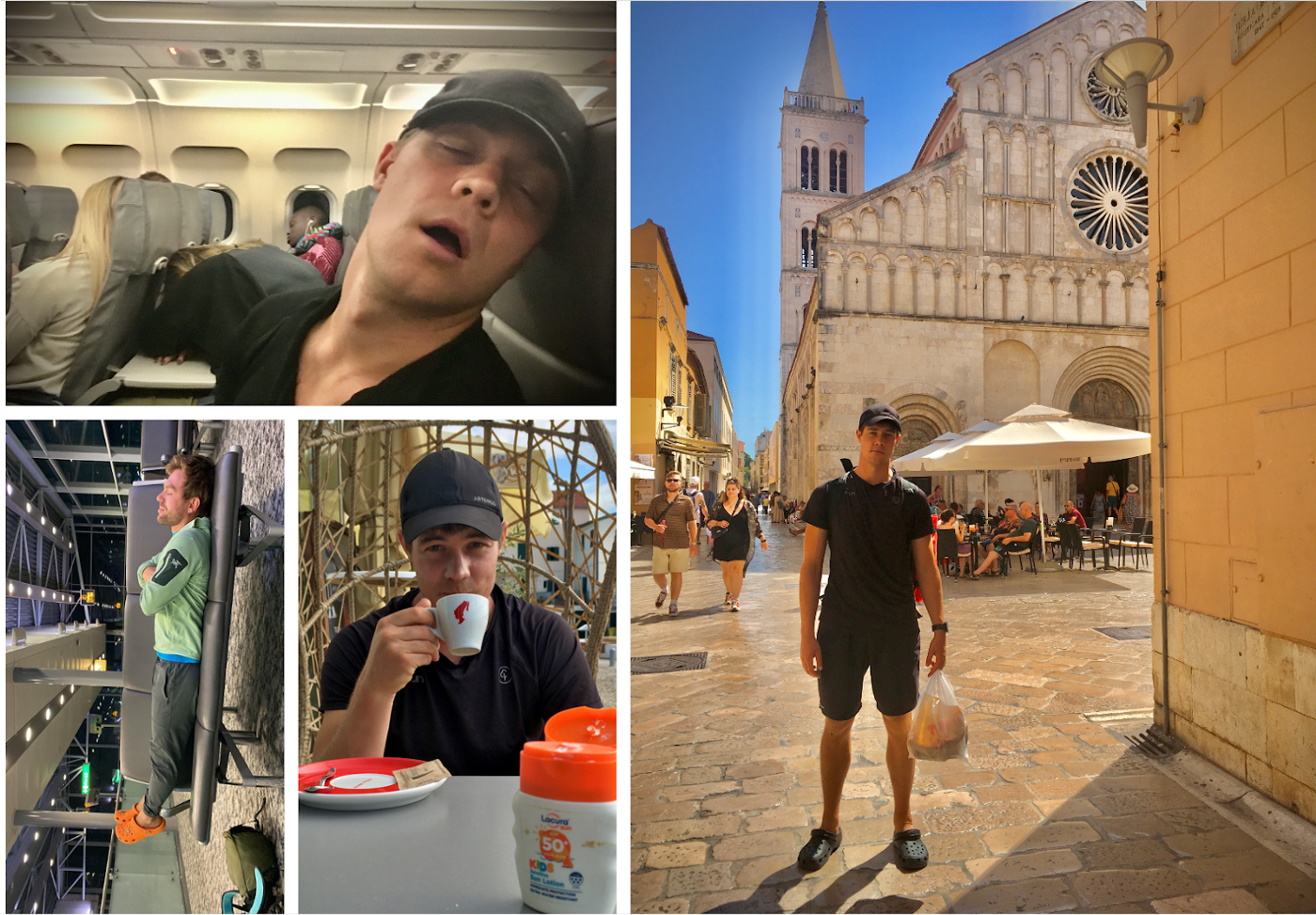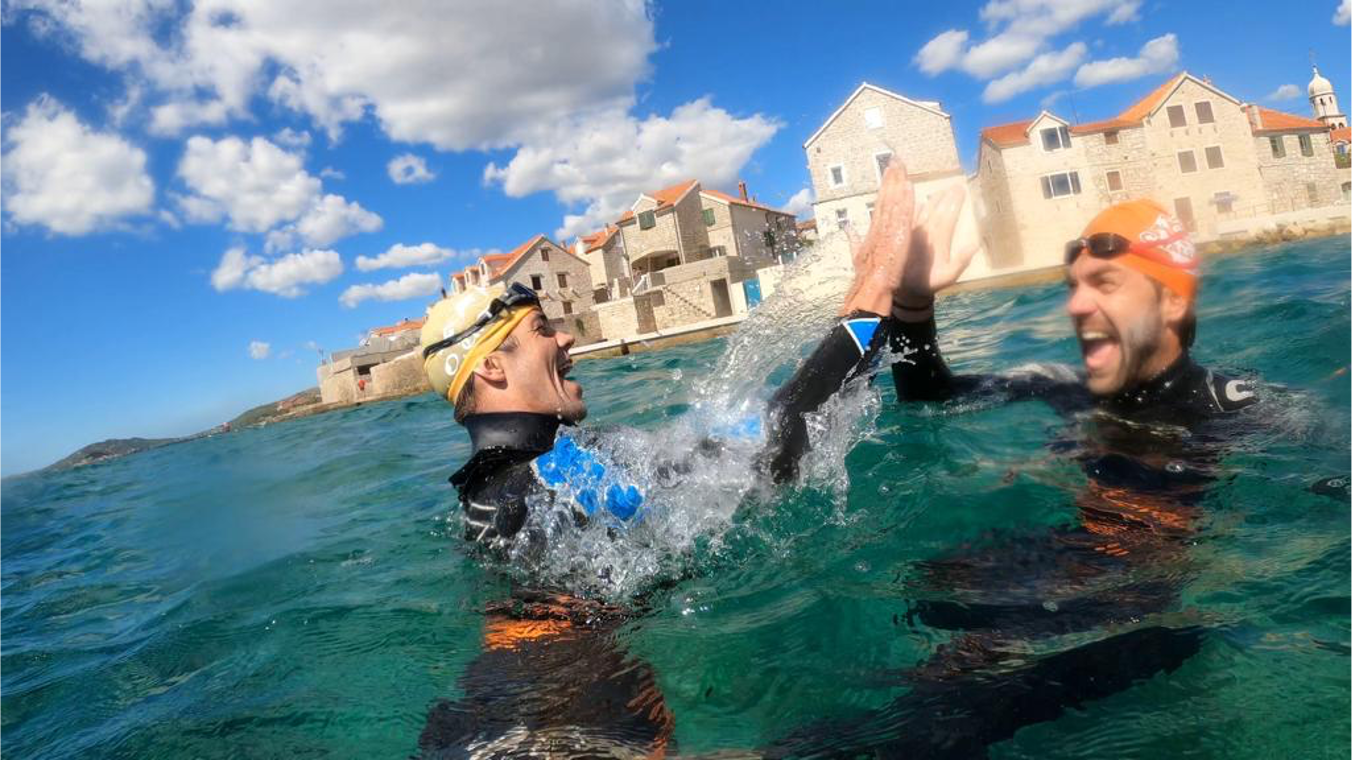Dalmatian Swim-tour
It’s a drag: Swim touring along Croatia’s Dalmatian coast.
All words and pictures by James Walker and Jerome Mayaud.
what is Swim touring?
Imagine swimming out to sea, finding a magical spot on a distant island, setting up camp, and falling asleep… And repeating that, over and over again. With just your own body strength to pull all your kit, and your friend next to you to make you laugh. Welcome to the new sport of ‘swim touring’*.
*(Ed’s note – we call it ‘cross country swimming’ but it’s the same thing. Carry on.)
Swim-touring, swim-packing, swim-trekking, expedition swimming: whatever you call it (cross country swimming – Ed), a multi-day swimming trip in open water, carrying everything you need with you, is the newest long-distance adventure on the block. Just like bicycle touring or overnight trekking, self-propulsion and self-support are the name of the game here.
However, swim-touring isn’t really possible without some kit that allows swimmers to effortlessly pull all their gear through the water — including shelter, clothing, food and water. Luckily, a few years ago, the smart folks at Above Below invented The RuckRaft, an elegant solution to this problem.
The RuckRaft is a fully inflatable raft that you drag behind you as you swim. It comes with a giant drybag, in which you can put an entire 70 L rucksack with all your kit. It all stays dry and allows you to drag 15 kg of kit with very low effort. It has to be tried to be believed!
We immediately saw the potential of the RuckRaft. It wouldn’t just allow us to combine walking and trail running with the occasional swim. It would actually unlock a whole new sport for us both, who love long-distance swimming and wild camping: a way of immersing ourselves in water and getting new perspectives on landscapes, and reaching sleeping spots that would otherwise be unreachable without a craft.
Why the Dalmatian Coast?
We approached this swim tour with a spirit of learning. Having never tried it out before — and with very little information available online — we anticipated getting a few things wrong. So we decided to choose a forgiving destination for this proof-of-concept adventure.
We drew up a list of key attributes our destination should have:
Warm seas with few currents and small tides, and no crossings longer than 1 km to minimise risk.
A good climate in September, with few chances of thunderstorms that make swimming and camping dangerous.
Simple and cheap transportation to/from the UK.
Plentiful infrastructure along the coast, including shops for food and water and ground transportation in case we needed to bail on our route.
Good mobile phone coverage in case of emergency or changes of plan.
Exciting coastline with plenty of uninhabited islands and options to get onshore easily if conditions changed.
The Mediterranean Sea ticks all these boxes. Greek islands first caught our imagination, and we got excited about swimming our way around an entire island. Mykonos and Milos stood out, but we soon realised they would be far too touristy or expensive to get to. Other countries crept onto our list, including Montenegro and Albania, but the lack of predictable food and freshwater sources along their coastlines put us off.
In the end, Croatia seemed like the best option. It has frequent, direct flights to the UK, and crucially, has crystal-clear waters that stay warm well after summer has ended. We knew it might have quite a bit of boat traffic, and that wild camping is technically not permitted there, but in the spirit of winging it, we booked our flights to the magnificent coastal city of Zadar.
Fleetingly, we’d considered swimming around the Kornati Islands archipelago, which can be reached by ferry from Zadar itself, but the logistics seemed difficult and water sources scarce. Instead, we set our sights on the Dalmatian Coast to the south. Onwards!
Quick shoutout to Swim Trek, who publish detailed maps and itineraries for their swimming holidays online, including along the Dalmatian Coast. We drew a lot of inspiration from their trek notes. Also, one of the RuckRaft’s inventors, Will, was a font of knowledge and encouragement as we planned our trip and amassed our kit. He’s someone who oozes passion for swim touring, and we’re grateful for his support.
Our swimming route, covering 60 kilometres of the Dalmatian Coast from Drage to Vodice.
An inauspicious start
As the saying goes: fail to prepare, prepare to fail. We hadn’t quite planned for a four-hour flight delay, so we hadn’t envisaged getting to bed at 4am in Zadar. We’d also forgotten how painfully easy it is to be fleeced by a taxi driver who’s been dealt the upper hand in the game of supply-demand market economics in the middle of the night in an unknown airport.
All that aside, there was a real sense of excitement that our trip was finally underway. It helped us soar through the lack of sleep on our first day. Fuelled by coffee and delicious local burek — a pastry made of thin flaky dough that’s stuffed with cheese or spinach, which would become our constant companions throughout the trip — we wandered along the gorgeous cobblestones of Zadar’s Old Town, before catching a cheap bus to Drage, a small coastal town a couple of hours to the south.
Clockwise from bottom left: Our comfy Crocs never left us, even in sleep; Much delayed bedtime courtesy of Ryanair; Morning wander around Split’s gorgeous Old Town; Countless coffees fuelled our adventure.
We arrived as the sun was dipping over the archipelago in front of us. The local beachgoers looked on, bemused, as we blew up our RuckRafts and loaded them up with our gear, strapping our water bladders and some bananas to the outside straps for easy access.
The sea was turquoise and warm. Our neoprene shorts felt like a second skin. We were finally here. The swim tour had begun.
Vagrant vessels, crazy currents
Our first evening swim couldn’t have gone more smoothly; a solid 5 kilometres following a gorgeous bay and then crossing over to a group of small islands from the tip of a peninsula. The sun had set so we picked a welcoming beach on the southern tip of Arta Vela island and camped under the stars.
We already got a small taste for the biggest recurring danger of our trip: speedboats and sailing boats crossing our path. Throughout our trip, any occasion for a big crossing was made more stressful by the threat of a collision with a vessel.
Day 2 began with some fun meandering through the cluster of wild islands to the northeast of Murter, the biggest island we’d encounter on our journey. A big thunderstorm had been announced for that afternoon and night, so we got 10 kilometres under our belt by the early afternoon, and decided to stay the night in a small guesthouse in Murter town. We’re glad we did, because the downpours and thunder that night were immense. Staying in town gave us the chance to celebrate our small successes with a scenic walk, some tasty food and a shower!
Clockwise from top left: Approaching the start of our first leg at Drage beach, with some bemused onlookers; An unorthodox method for carrying the Ruckraft around on dry land; Sometimes it’s good to spread; The start of our third day among the bridges of Betina, with its pseudo-Venetian vibes.
We’d been warming ourselves up for Days 3 and 4, which we planned to be our big days of swimming. We began by swimming out of Betina, a quaint Venetian-esque town on the eastern side of Murter, and towards Tisno, a town connected to the Croatian mainland via a bridge straddling a small channel.
We probably should have guessed that such a narrow channel would create some strong currents due to the tidewater funnelling through it. And if we’d checked the tide tables (a rare necessity in the Mediterranean), we would have probably worked out that those strong currents would be working against us the whole time. We didn’t, on both counts.
We made it through to the other side — just. Once again, we must have been a bit of a spectacle for the confused locals who gathered on the bridge to watch our heroically pointless efforts. We think we saw somebody clap, but we can’t be sure; it was probably ironic anyway.
Luckily, we were rewarded with calm waters on the swim down towards the next settlement of Jezera. After stocking up on some bottled water from the local store, and avoiding the trillions of sea urchins lurking under the surface — praise thee, Crocs! — we headed for the small island of Bisaga in the setting sun.
We hit our largest, choppiest crossing on the final run down to Bisaga. It was a tough 20 minutes battling head-on against big windblown waves, but the fight was worth it; Bisaga felt like a little slice of heaven, all to ourselves.
At this stage, a bit of wear and tear was creeping in. James’s wetsuit developed a very fetching hole right up his bum crack, while Jerome’s tongue started swelling in weird places due to spending so long in the salty sea. What’s more, on that third night we put up the tarp (why bring it if you’re never going to put it up?!), but there was not a breath of wind. A terrible combination leading to a night of hot, interrupted sleep.
But we didn’t care. The adventure was in full throttle, and we were on the edge of the world.
Clockwise from top left: Pushing off for of our last day of swimming, under a bluebird sky; A rare chance for a photo to be taken of both of us by somebody else; Our mamas would be so proud.
A thunderous threat
Day 4 would be a biggie, for many reasons. First, the swim distance: at 14 kilometres, it was our longest of the trip. It was also our wildest, because for miles on end we followed big cliffs that had no road access and therefore offered no way of escaping the seas if something went wrong. It was thrilling, beautiful, and at points felt interminable.
After a bit of confusion about whether we’d reached the bay of Tribunj — we hadn’t, so back into the sea we went — we landed at a gorgeous beach where we loaded up on some stellar burek. Wandering the baking hot streets, we finally found a supermarket and snaffled dinner for the evening.
Our dinners were all variations on a theme: tins of tuna combined with rice and vegetables (the salmon-pink ‘Rio’ tins were our favourite), which we’d dump over a mound of couscous soaked in cold water. We’d highly recommend this menu as a simple way of getting lots of calories without needing a stove. It’s not sophisticated, but anything tastes good compared to mouthfuls of seawater for hours on end.
Clockwise from top left: Stunning sunset views from our camp at the top of Tijat island (shortly before the thunderstorm from hell); A hot and stuffy night under the tarp on Bisaga island; Heartbreaking goodbye from our random German kayaker friend on Tijat; A poor tongue slowly getting used to spending many hours per day in salty water; Breaking camp at the crack of dawn on rocky, remote Arta Vela.
The final swim of Day 4 saw us skirting the eastern side of Logorun island, crossing the strait to Tijat island, and pulling into a bay halfway along it. There we met a funny German chap who’d been kayaking for several months; the one and only other person we met on our trip who was self-propelling down the Croatian coast. We climbed several hundred metres to the summit of Tijat island, where we set up camp right underneath an imposing metal cross.
Fast-forward eight hours, and lightning strikes. We both jolt awake in our bivvy bags, as rain starts pouring onto us and the hills on the mainland a few miles away glow with harsh thunderbolts. We’ve cleverly chosen the one spot that will almost certainly receive a strike if those electrons all line up. We stumble down the hill, half-asleep, anxiously giggling about this mad turn of events.
To be fair, we’d meticulously checked multiple weather apps to check for thunderstorms heading our way before going to sleep, and none had been predicted. But this was an important lesson in not taking weather models for granted, and always having an escape plan.
Shaken, but not deterred, we picked ourselves up and plunged into Day 5 with aplomb. It turned out to be a real corker.
A lap of honour
Retracing our strokes back along the east coast of Tijat and Logorun, we struck east towards Vodice, a bustling, touristic town with a fun vibe. Timing our arrival to perfection, we jumped onto a local ferry service that connects the islands of Prvić and Zlarin to the mainland. 15 minutes later, we were ambling onto Prvić, bags and RuckRaft in hand, settling in for a coffee on surely the cutest town squares we’d encountered.
The sea had become choppy once again, but luckily the strong current was moving with us as we swam anticlockwise round towards the small little island of Lupac. We stopped for the night on a shore platform with a stunning backdrop of olive trees, and the sun setting in front of our camp. We felt lucky: we’d survived the thunderstorms that morning, and we’d had a stunning day of swimming. It felt like we could do this forever.
Our sixth and final day was all about completing our ‘lap of honour’ around Prvić. Stopping off for — you’ve guessed it — a morning coffee in the breathtakingly beautiful harbour of Prvić Luka, we circumnavigated the island, flying over vibrant coral reefs and shoals of fish suspended in the impossibly turquoise void.
At the edge of ethereal
Our last photo of the trip, below, says it all. We couldn’t have dreamed of a more welcoming sea. Each Croatian village we passed was even more picturesque than the last. We got better at swimming, and we didn’t get squished by a speedboat. Even James’s wetsuit made it all the way to Vodice — just.
Swim-touring together brought us to the edge of something ethereal. It was the adventure, the thrill of the effort, the curiosity of the unknown, the delight of the discovery, the fear of the crossing, the meek laughs of relief as well as the belly laughs of joy. It was something that this blog post may not really put into words, but it happened, whatever it was.
And it’s changed our friendship for good.
Pleasure floating with you, James. And you, Jerome.
Tips for comfortable swim touring
Here are a few handy tips of things we’d definitely do again next time:
Crocs are friendly*: Whether it’s travelling to your chosen spot, stomping around camp, or occasionally walking to a shop or cafe to resupply, swim-touring involves spending a lot of time on your feet. For this, we found nothing better than the cheap, waterproof, and ultra-sturdy Croc. In Croatia, which is infamous for the painful sea urchins lurking right below the surface, we found our Crocs invaluable for getting in and out of the water safely. Even if they break (one of ours did), Crocs are simple to fix. Neither of us wore anything other than Crocs during the entire trip — including at the airport and on the flight. Cringe, but comfy.
(*Ed - we concur on Crocs but we prefer Chaco sandals, see the AB Kit List in the blog)
Attach water and snacks on the outside of your RuckRaft: When swimming and you’re in the flow, there’s nothing worse than having to swim to shore for a quick drink or snack for an energy boost. We found that clipping a water bladder (a Platypus or Camelbak) to the handy straps on the RuckRaft allowed us to take regular sips of water, which helped us keep hydrated in the Croatian sun. Our snacks of choice included bananas, oranges and tangerines, because they (i) are healthy, (ii) remove the salty taste of water that lingers throughout your swim, and (iii) have their very own natural packaging!
Protect your skin: Predictably, swimming in salty seawater can start wearing on your skin after a while, especially in areas where wetsuit neoprene rubs repeatedly on skin. A particular hotspot is the neck, which can often be cut red raw on long sea swims. Luckily, we’d bought Mugiro neck protectors ahead of our trip, and didn’t regret the hefty price tag one bit; they’re comfortable, dependable, and simple to use. Even on the days we didn’t wear our wetsuits, our front crawl movements gave us chafing under our armpits, so Bodyglide was essential.
If you’d like to read more from Jerome Mayaud, head to his blog.






